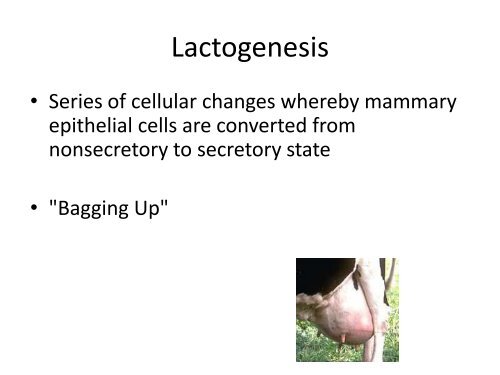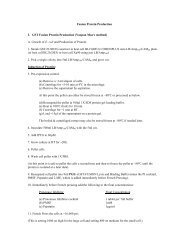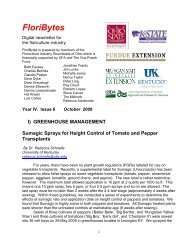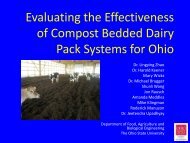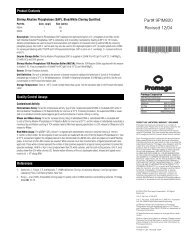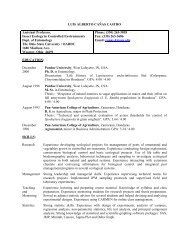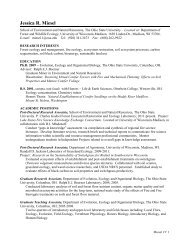Lactogenesis
Lactogenesis
Lactogenesis
You also want an ePaper? Increase the reach of your titles
YUMPU automatically turns print PDFs into web optimized ePapers that Google loves.
<strong>Lactogenesis</strong><br />
• Series of cellular changes whereby mammary<br />
epithelial cells are converted from<br />
nonsecretory to secretory state<br />
• "Bagging Up"
2 Stages of <strong>Lactogenesis</strong><br />
• Cytologic and enzymatic<br />
– Alveoli change<br />
– Limited synthesis<br />
– 2 wk prior to calving
Mammary cytology changes at calving<br />
• Cell polarity<br />
• Resting to active synthesis
2 Stages of <strong>Lactogenesis</strong><br />
• Copious secretion<br />
– All milk products<br />
– 0 to 4d prior to calving<br />
– 2 to 3d after calving
Insulin + GLU + prolactin<br />
• All cytological and enzymatic changes<br />
• Copious secretion
Key hormonal event at calving<br />
• Progesterone<br />
decreases
Relative Concentrations<br />
of Estradiol and Progesterone
Progesterone<br />
• Key negative regulator<br />
• Competes for GLU receptors<br />
• Decreases 2 d prepartum<br />
• Suppresses lactose and protein synthesis
Cows milked prepartum<br />
• Significant # milk<br />
• Composition differs among qrts milked and<br />
unmilked<br />
• Suggests local factors
Maintenance of lactation<br />
• Galactopoiesis<br />
• Milk removal<br />
required
Hormonal control of galactopoiesis<br />
• Complex of hormones<br />
• Prolactin **<br />
• Growth hormone<br />
• GLU<br />
• Thyroid hormones
Prolactin<br />
• Role species specific<br />
• Not limiting in cows<br />
• Limiting in nonruminants<br />
• Levels increase as milking occurs
Prolactin altered by environment<br />
• Temperature<br />
• Light
Growth hormone<br />
• Galactopoietic in<br />
cows<br />
• Blood levels<br />
follow milk curve
Growth<br />
Hormone
Stage of Lactation and Persistency
Glucocorticoid<br />
• Essential for maintenance<br />
• Not limiting in cows
Thyroid hormones<br />
• Essential for maximal yield<br />
• Diet thyroprotein increases milk<br />
– Short term<br />
– Must increase feed intake<br />
– Subsequent yields below normal
Milk removal and galactopoiesis
Milk removal<br />
• Required for galactopoiesis<br />
• Nursing/milking triggers galactopoietic<br />
hormones
Milk removal<br />
• Stop milking; increase udder<br />
pressure<br />
• Pressure increases decrease blood<br />
flow
Autocrine control<br />
• Local feedback factors<br />
• Effects not explained by hormones
Experiment:<br />
Milking Frequency<br />
Udder halves<br />
1 2<br />
Milked 2x/day 3x/day<br />
More milk
Human <strong>Lactogenesis</strong><br />
• Prolactin limiting<br />
• Copious secretion 2-5 d postpartum
Human Galactopoiesis<br />
• Galactopoeitic complex<br />
• Milk Removal<br />
• Prolactin
Pseudopregnancy<br />
• Estrus Cycle<br />
– Proestrus 9 d<br />
– Estrus 9 d<br />
– Diestrus* 60-90 d<br />
– Anestrus 120-160 d
Pseudopregnancy<br />
• Common signs<br />
– Maternal behavior<br />
– Nesting<br />
– Mothering inanimate objects<br />
– Mammary enlargement<br />
– Milk release<br />
• self-nursing<br />
• adaption unrelated neonates
Pseudopregnancy<br />
• Evolutionary function<br />
– Foster mothers in packs
Pseudopregnancy<br />
• Hypertrophy = tissue enlargement<br />
– Most common in caudal abdominal glands
Pseudopregnancy<br />
• Hormones<br />
– Extended time of high progesterone<br />
– Abrupt reduction in progesterone<br />
– Increased prolaction


